
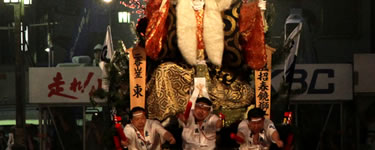
Yamakasa History & Origins Explained
Yamakasa History & Origins Explained
A little Geography
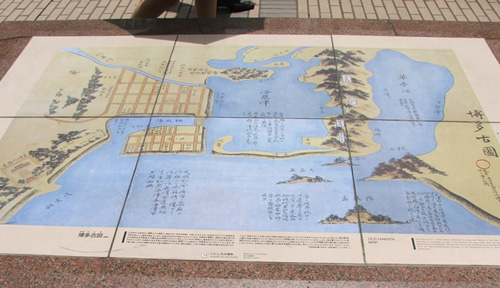
A map of “Old Hakata” on a stone display near my work in Taihaku-doori.
————————————
Although Fukuoka city stretches out all across Hakata Bay area these days, by far the oldest part of the city is the area now known as the “Hakata Ward”. Always a town full of traders, Hakata was the first port of call for contact, trade and diplomatic missions to Korea and China.
It’s the closest part of Japan to Korea, and a ferry these days will take about 3 hours to cross the Korea Strait. Being one of the first ports of call for foreign trade made Hakata prosperous, but brought many invaders and wars as well.
Importantly in the 1500s and 1600s, as Hakata prospered people began to fight over who would have control over the town. One smart guy decided to burn the whole lot down, and (on chasing out his opponents, defeating them on the exit and claiming the town) remapped and rebuilt everything.
This is how the seven “nagare” or “streams” came about.
Called so possibly because of their length, each of Hakata’s subdivisions was chosen with either rivers or new major roads as its boundaries. These seven traditional districts made up old Hakata town.
This map shows the 7 traditional districts. With some rough Kanji translation, left to right:
Nakasu Nagare (from the river, the “Sandbar in the Middle Stream”)
Daikoku Nagare (“Big Black Stream”)
Doi Nagare (“Living on the Soil Stream”)
Nishi Nagare (“West Stream”)
Ebisu Nagare (Ebisu is the God of Fishing, so “God of Fishing Stream”)
Higashi Nagare (“East Stream”)
Chiyo Nagare (“Thousand Ages/Thousandth Era Stream”)
You can see Hakata Station to the bottom right (博多) and Nakasu River (中洲川) marked to the bottom left. Nakasu river was the old border of Hakata city; when the country was united under Samurai rule a castle was built and a new city founded across that river. This newer city of Fukuoka, though smaller, became the namesake when they combined in the 1880s. Which is why Kyushu’s capital is Fukuoka, and not Hakata.
Nakasu Nagare (from the river, the “Sandbar in the Middle Stream”)
Daikoku Nagare (“Big Black Stream”)
Doi Nagare (“Living on the Soil Stream”)
Nishi Nagare (“West Stream”)
Ebisu Nagare (Ebisu is the God of Fishing, so “God of Fishing Stream”)
Higashi Nagare (“East Stream”)
Chiyo Nagare (“Thousand Ages/Thousandth Era Stream”)
You can see Hakata Station to the bottom right (博多) and Nakasu River (中洲川) marked to the bottom left. Nakasu river was the old border of Hakata city; when the country was united under Samurai rule a castle was built and a new city founded across that river. This newer city of Fukuoka, though smaller, became the namesake when they combined in the 1880s. Which is why Kyushu’s capital is Fukuoka, and not Hakata.
And how did the festival start?
The most commonly told origin story is set in the 1500s. When a plague (or some say drought) struck Hakata it is said that a Monk was carried around on a sort of platform by local townspeople. He went throughout all of Hakata spraying holy water everywhere to exorcise the sickness, and lo and behold once he was finished the sickness went away.
Ever since Kushida Shrine was originally built (in the 760s AD, apparently!) it’s been seen as Hakata City’s guardian shrine. The monk’s actions turned over time into a yearly thankyou ceremony for the gods of the Kushida shrine, starting on the shrine’s grounds.
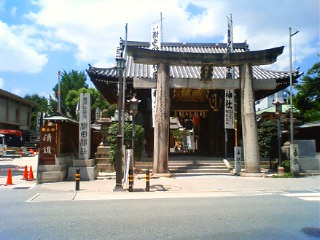
Rivers and Mountains
Aha, you thought all that geography was for nothing! Actually the seven “streams” that divided Hakata City are a central part of festivities. Every year each one of these seven streams will build one Kakiyamakasa or Kakiyama: (roughly translates to “Carry Mountain”)
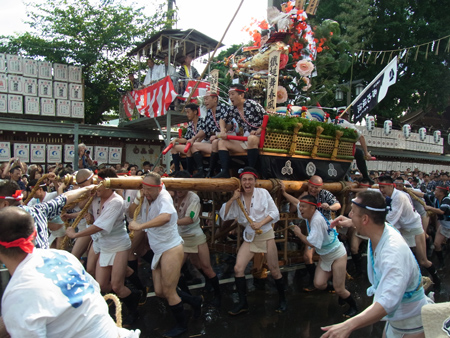
The mikoshi that gets carried along a decided route across town.
As well as Kakiyama there are Kazariyamakasa or Kazariyama: (“Display Mountain”)

The big, multi-storey mountains of dolls and decorations based on traditional & modern themes that stay put and remain on display throughout the festival.
The big reveal of all the Kazariyama on the 1st of July every year is what kicks off the festival proper. Work will begin on these elaborate displays in April, though some streams will get going as early as January.
Why build two?
Actually in the old days, Yamakasa would be done with the enormous, gorgeously decorated Kazariyama. But thanks to all the powerlines in Hakata City from the 20th century onwards it became more and more difficult to get around. Also thanks to urban sprawl there are less and less people actually living in Hakata City (though lots of people work there), and as it’s a festival for locals you need some blood ties to the Hakata streams to participate.
Not wanting to skip out on the grandeur but aware of the need for a shorter Mikoshi carryable by fewer participants, it seems that the citizens of Hakata decided to make two. So while the Kazariyama are built to their full size and grandeur, the shorter and more portable Kakiyama are the ones that actually get raced around town.
Also as more and more of Fukuoka city gets in on this famous festival, you’ll see Kazariyama popping up all around town – even as far as the Yahoo Dome baseball stadium wayyy to the west (you have to scroll to find it)
より大きな地図で 博多祇園山笠 山小屋マップ【山笠ナビ】 を表示
—————-
This map here shows the Kazariyama around town in red, and the Kakiyama that’ll be coming up through the week in blue. Notice how the blues are all around old Hakata, and the reds stick out all over?
Why do they run, and where do they run to?
The course has developed over time to start at the Kushida shrine and then meander through each “stream” of Hakata city to end at a decided goal point near the Nakasu river.
This course is run twice, as a practise run on the 12th of July and as the final climax to festivities “Oiyama” on the morning of the 15th.
At first, while each stream competed for the biggest and flashiest Kazariyama to display the Oiyama was actually more of a parade. It makes sense that the beautiful, dramatically decorated Kazariyama should be shown off in class to the city of Hakata. Even now the order that the streams go in is decided and rotated, so that each gets to lead the procession once every 7 years.
But at a certain point in the 1680s the Doi Nagare’s team took a breather at Tochouji Temple (in Gokusho-machi, at point 6 along the big yellow road) and the two teams behind it decided to overtake them to the finish line. That’s how the tradition of racing to the finish was born.
So what happens at Yamakasa?
Firstly the Kazariyama are presented to the public on the 1st of July, then each “stream” will reveal its Kakiyama on signated dates throughout the proceeding week. There are a few shorter courses and some display events, like a straight run from Hakata to Tenjin. On the 12th a practise run-through will happen along most of the route. The real run, Oiyama, will happen on 4.59 am on the 15th of July, which this year is a friday.

Pre-race formalities, 2010.
—-
The course, around 5km long, starts at the Kushida shrine. Participating streams will line up there according to the rotation system (as the lead only happens once every 7 years, it gives the stream major bragging rights) and at 4.59 am sharp, the line is dropped and the first team picks up their Kakiyama and runs. Others follow at 5 minute intervals.

Some of the streets on the course are really, really tiny…
—–
Participants will loop around parts of Kushida shrine before heading uptown to just past the main street of Taihaku doori, then loop back and trickle down through each “stream” of Hakata before reaching the goal point.
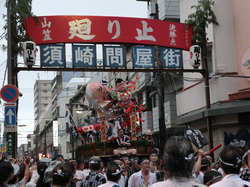
Goal Point!
——
The teams compete against the clock to get under the 30 minute mark. Each team has several hundred members that run alongside and take turns to carry the Kakiyama as others tire. 32 carriers will be underneath it at any one time.
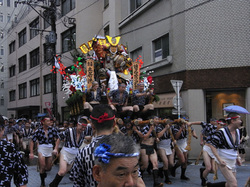
In mid-stride
——
Spectators will be spraying water on the teams and cheering them on, and everything is hyper-tense and exciting! Then the entire thing wraps up by about 7 or 8 in the morning, everyone packs up and goes straight to work. That’s Japan for you!
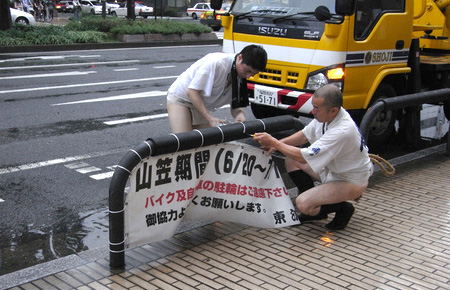
And some Tidbits:
The Yamakasa festival tends to fall at the end of the rainy season in Fukuoka, and is said to bring in true summer – last year it did just that, with a huge downpour during the Oiyama that cleared up by evening taking the last of the rain with it.
Although the festival attracts nearly a million tourists from all over Japan and is broadcast on national television, because it’s Hakata’s local occasion the other townships in Fukuoka city just don’t have much to do with it. One festival that does bring all of Fukuoka City together is the Hakata Dontaku Matsuri held in spring near Golden Week.
The “sumo undies” that participants wear might be a shocking sight to overseas visitors, but until the 20th century that was ALL that the participants wore. Thanks to a westernised way of thinking in the 1920s, people considered shutting down the Hakata Yamasaka Festival because they found the clothing style too indecent. As a way around the new prudishness, Happi Jackets were added to the official participant outfits. Most of the practise, ceremonies and preparation is done in a uniform with pants, so expect “sumo undies” only on the festival’s real events.
——
That covers most of the basic points, just in time for the festival proper to begin… stay tuned!
Yamakasa-Navi Correspondence
Viewing Guide
Trivia
Even More Information




